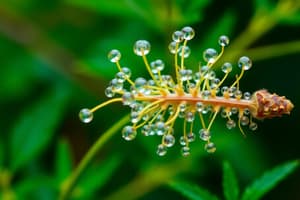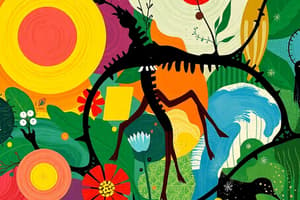Podcast
Questions and Answers
What term describes a chemical structure made up of at least two atoms connected by chemical bonds?
What term describes a chemical structure made up of at least two atoms connected by chemical bonds?
- Organelle
- Tissue
- Molecule (correct)
- Macromolecule
Which level of biological organization includes groups of similar cells carrying out similar functions?
Which level of biological organization includes groups of similar cells carrying out similar functions?
- Cells
- Organ Systems
- Organs
- Tissues (correct)
What is the primary source of biological diversity?
What is the primary source of biological diversity?
- Geographic distribution
- Evolution (correct)
- Biochemical pathways
- Cellular structure
What is the term for a diagram showing evolutionary relationships among biological species?
What is the term for a diagram showing evolutionary relationships among biological species?
Which field of study focuses on the interactions among organisms and their environment?
Which field of study focuses on the interactions among organisms and their environment?
What is the primary focus of basic science?
What is the primary focus of basic science?
What step involves conducting experiments to determine the validity of a hypothesis?
What step involves conducting experiments to determine the validity of a hypothesis?
Which property of life involves the ability to respond to environmental changes?
Which property of life involves the ability to respond to environmental changes?
In which section of a scientific paper would you typically find the experimental details and procedures?
In which section of a scientific paper would you typically find the experimental details and procedures?
What is the purpose of a control group in an experiment?
What is the purpose of a control group in an experiment?
Which of the following describes applied science?
Which of the following describes applied science?
Which of the following properties is NOT considered a characteristic of life?
Which of the following properties is NOT considered a characteristic of life?
What is a potential outcome after analyzing the results of an experiment?
What is a potential outcome after analyzing the results of an experiment?
Which of the following best describes biology?
Which of the following best describes biology?
What is the primary role of the scientific method in research?
What is the primary role of the scientific method in research?
Inductive reasoning is primarily characterized by which of the following?
Inductive reasoning is primarily characterized by which of the following?
Which of these fields is NOT considered a part of the natural sciences?
Which of these fields is NOT considered a part of the natural sciences?
What distinguishes a verified theory in science?
What distinguishes a verified theory in science?
Which of the following represents deductive reasoning?
Which of the following represents deductive reasoning?
How does the scientific method apply to natural sciences?
How does the scientific method apply to natural sciences?
Which statement accurately reflects the characteristics of natural sciences?
Which statement accurately reflects the characteristics of natural sciences?
Flashcards are hidden until you start studying
Study Notes
What is Biology?
- Biology is the study of life, encompassing everything from microscopic cells to ecosystems and the entire living planet.
- It includes diverse areas like finding cures for diseases, protecting the environment, and addressing global challenges like climate change.
The Process of Science
- Science aims to uncover general truths about the world using the scientific method.
- The scientific method involves carefully designed experiments to test hypotheses through repeatable observations.
- A hypothesis is a proposed explanation that can be tested.
- A verified theory is a tested and confirmed explanation for observations and phenomena.
- Natural sciences focus on the physical world and its phenomena.
Natural Sciences
- Examples of natural sciences include: astronomy, biology, computer sciences, geology, logic, physics, chemistry, and mathematics.
Scientific Reasoning
- Inductive reasoning uses specific observations to draw general conclusions. It is used in descriptive science.
- Deductive reasoning uses a general principle to predict specific results.
The Scientific Method
- The scientific method provides a systematic approach to solving problems.
- It involves:
- Observation - identifying a problem to investigate.
- Hypothesis - proposing an explanation for the problem.
- Prediction - formulating a testable statement based on the hypothesis.
- Experiment - conducting controlled tests to gather data.
- Analysis - interpreting the data and drawing conclusions.
- Reporting - sharing the findings with the scientific community.
Two Types of Science
- Basic science focuses on expanding knowledge, regardless of immediate applications.
- Applied science uses science to solve real-world problems and create products or services.
Reporting Scientific Work
- Scientists share their findings through peer-reviewed manuscripts published in scientific journals.
- A scientific paper typically includes:
- Introduction: Background information and the research question.
- Materials and Methods: Description of the experimental procedure.
- Results: Presentation of the experimental data.
- Discussion: Interpretation of the results and their significance.
- Acknowledgments: Recognition of contributions from others.
- References: List of sources used.
- Abstract: A concise summary of the research.
Properties of Life
- Order: Living organisms are highly organized.
- Sensitivity or Response to Stimuli: Organisms respond to changes in their environment.
- Reproduction: Organisms produce new individuals of the same kind.
- Adaptation: Organisms evolve over time to suit their environment.
- Growth and Development: Organisms increase in size and complexity.
- Regulation/Homeostasis: Organisms maintain a stable internal environment.
- Energy Processing: Organisms acquire and use energy to carry out life functions.
- Evolution: Organisms change over generations, leading to diversity.
Levels of Organization of Living Things
- Atom: Basic unit of matter.
- Molecule: Two or more atoms bonded together.
- Macromolecule: Large molecules formed from smaller units.
- Organelles: Functional structures within cells.
- Cells: The basic unit of life.
- Tissues: Groups of similar cells performing a specific function.
- Organs: Tissues working together to carry out a complex function.
- Organ System: Multiple organs working together.
- Organisms: Individual living entities.
- Populations: A group of organisms of the same species in a particular area.
- Communities: Different populations living together.
- Ecosystems: All living and nonliving factors in a specific area.
- Biosphere: All ecosystems on Earth combined.
The Diversity of Life
- Evolution is the process of gradual change in a population over time, driving the diversity of life.
- Phylogenetic Tree: A visual representation of evolutionary relationships between species based on shared characteristics.
Branches of Biological Study
- Molecular Biology and Biochemistry: Studies the structure and function of molecules in living organisms.
- Microbiology: Studies microorganisms like bacteria and viruses.
- Neurobiology: Studies the nervous system.
- Paleontology: Studies fossils and ancient life.
- Zoology: Studies animals.
- Botany: Studies plants.
- Biotechnology: Applies biological knowledge to solve problems.
- Ecology: Studies interactions between organisms and their environment.
- Physiology: Studies the functions of living organisms.
Studying That Suits You
Use AI to generate personalized quizzes and flashcards to suit your learning preferences.




